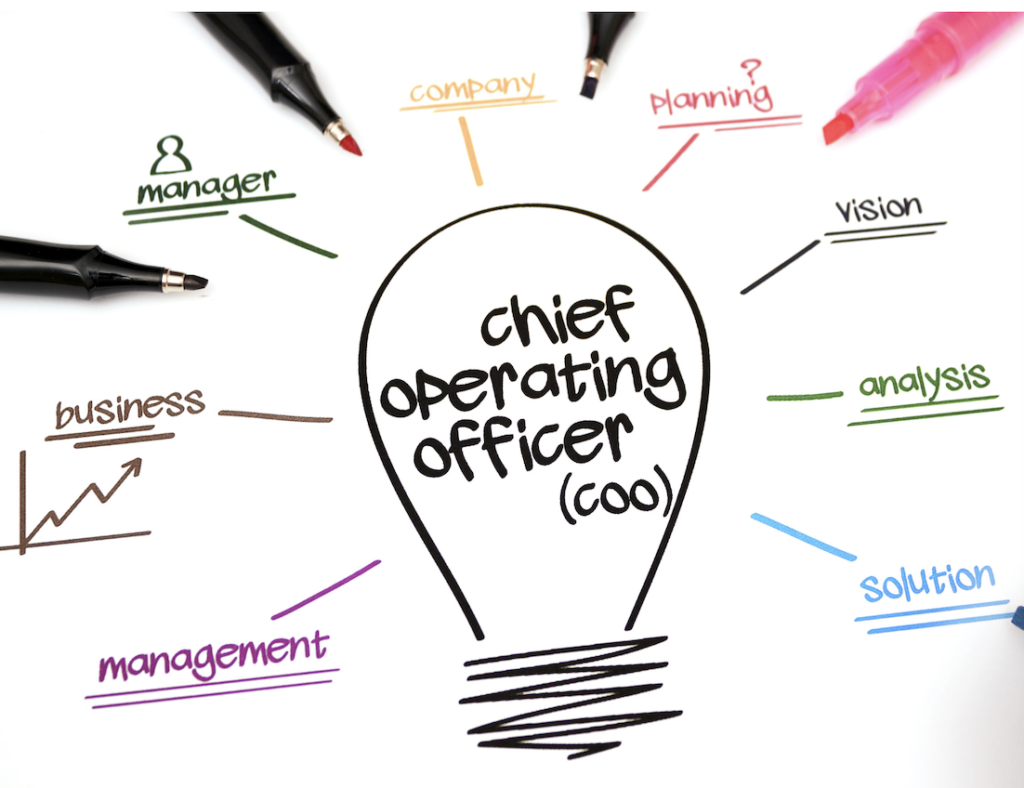
The Chief Operating Officer (COO) faces numerous challenges and opportunities since they oversee all levels of operations. One of their biggest challenges, which is common to most c-suite executives, is losing focus on the strategy due to being overly focused on execution. The challenges faced by each COO are dependent on the size, industry, and location of their organization, and there is no universal way of managing operations.
However, there are five primary challenges that COOs typically face:
I. Lack of alignment
Engaged employees are crucial for the success of any organization. When employees are not engaged, it can lead to reduced job satisfaction, conflicts among colleagues, and a negative workplace culture. Furthermore, disengaged employees can negatively impact an organization’s ability to attract and retain talented individuals. This can result in a toxic work environment, which can ultimately lead to higher rates of employee turnover.
II. Operational redundancies and inefficiencies
One of the significant challenges faced by a Chief Operating Officer (COO) is dealing with operational redundancies and inefficiencies within the organization. These inefficiencies can manifest themselves in many forms, such as duplication of efforts, unnecessary bureaucracy, outdated processes, or poor communication between departments. These issues can result in a decline in productivity and increase in costs, leading to a negative impact on the bottom line. The COO must identify and address these inefficiencies by streamlining processes, identifying redundant tasks, and implementing new systems and technologies to optimize the organization’s operations. By addressing these challenges head-on, the COO can improve the organization’s overall efficiency, reduce costs, and improve the customer experience.
III. Poor engagement
Several COOs do not acknowledge the significance of having a guiding principle for their organization. Without gaining the support of your team, it will be challenging to achieve a common direction. Failure to promote shared objectives and obtain buy-in can have adverse effects on the organization’s long-term prosperity. To emphasize alignment, you can implement the following approaches: establishing well-defined goals, creating a guiding principle or North Star, encouraging a sense of urgency, adopting a growth-oriented outlook, committing to making changes, identifying and removing obstacles, and striving to create a strong corporate culture.
IV. Reactive data focus, and complex/outdated operating frameworks.
Another challenge faced by a Chief Operating Officer (COO) is dealing with a reactive data focus and complex/outdated operating frameworks. Many organizations struggle to keep up with the constant flow of data and often rely on reactive approaches to analyze and respond to it. This can result in missed opportunities and an inability to leverage data to make informed decisions. Additionally, many organizations have complex and outdated operating frameworks that hinder productivity and create unnecessary bureaucracy. The COO must address these challenges by implementing data-driven decision-making processes and streamlining the operating frameworks to optimize the organization’s operations. By adopting a proactive approach to data analysis and modernizing the operating frameworks, the COO can improve the organization’s overall efficiency and effectiveness.
While it is possible to address each challenge separately, a more practical and effective approach would be to find a solution that resolves all these issues at once.
Benefits of OKRs for COOs
The COO can derive various advantages from utilizing OKRs, which are a method of setting goals that helps to concentrate and synchronize the overall strategic direction of the organization towards achieving better results. OKRs prioritize achieving outcomes over merely increasing input, which is crucial for enhancing operations’ effectiveness. OKRs also promote team engagement, foster a culture of trust, and optimize operations for the present-day business landscape.
Need more OKR examples for your business? Reach more OKR Examples
New to OKRs? Start with the OKR fun course**
Also learn more about OKR and Agile processes How OKR and Agile Can Work Together
I. Aligning an organization’s strategic vision towards achieving better results
OKRs, a framework for setting goals that helps to concentrate and align an organization’s strategic vision towards achieving better results. OKRs offer several benefits for COOs, including the ability to align an organization’s strategic vision towards achieving better results. By setting clear objectives and key results, OKRs help to ensure that everyone in the organization is working towards the same goals. This promotes alignment and focus, which can lead to increased productivity and better outcomes. Additionally, OKRs provide a mechanism for measuring progress and identifying areas for improvement, which is crucial for driving continuous improvement. By utilizing OKRs, COOs can foster a culture of transparency, accountability, and collaboration, which can help to promote engagement and boost team morale. Overall, OKRs are an effective tool for COOs to align an organization’s strategic vision and drive better results.
II. Achieving impactful outcomes
The COO can benefit from utilizing rather than prioritizing input, OKRs emphasize the significance of achieving impactful outcomes, countering the traditional focus on efficiency. OKRs prioritize outcomes over inputs, meaning that they focus on what the organization wants to achieve rather than just the amount of work being done. This approach helps to ensure that the organization is making progress towards its goals and achieving meaningful results. By setting specific, measurable, achievable, relevant, and time-bound objectives, COOs can ensure that the organization is focused on achieving impactful outcomes. Additionally, OKRs provide a mechanism for tracking progress and identifying areas for improvement, which is crucial for optimizing operations and driving continuous improvement. Overall, OKRs are an effective tool for COOs to achieve impactful outcomes and drive the success of their organization.
III. Establishing a culture of trust:
Not only do OKRs foster engaged teams, but they also establish a culture of trust and optimize operations for the contemporary business landscape. The OKR process is sufficiently structured to enhance operations, yet transparent enough to connect strategic vision with execution, while remaining adaptable to meet the requirements of a modern operational model.
By setting clear objectives and key results, OKRs provide transparency and accountability throughout the organization. This transparency helps to build trust between team members, as everyone is aware of what their colleagues are working on and how their work contributes to the organization’s overall goals. Additionally, OKRs encourage collaboration and teamwork, as individuals and teams work together to achieve shared objectives. This collaboration fosters a culture of trust and respect, where team members can rely on each other to achieve their goals. By using OKRs, COOs can promote a culture of trust within their organization, which can improve engagement, reduce turnover, and ultimately drive better outcomes.
Benefits of using Software Platforms
There are several benefits of using software platforms for Chief Operating Officers (COOs) to manage OKRs. First and foremost, software platforms provide a centralized location for setting, tracking, and managing OKRs across the organization. This improves efficiency and reduces the potential for errors or miscommunications. Additionally, software platforms provide real-time data and analytics, allowing COOs to monitor progress and identify areas for improvement quickly. This helps to ensure that the organization is making progress towards its goals and achieving meaningful outcomes. Furthermore, software platforms offer collaboration features that enable team members to work together on OKRs and share updates in real-time. This fosters a culture of teamwork and accountability, which can ultimately lead to improved engagement and better outcomes. Overall, using software platforms to manage OKRs can improve efficiency, increase accountability, and drive the success of the organization
I. Making Proactive Decisions
To avoid making reactive decisions, ConectoHub emphasizes usability and accessibility in its data-driven execution approach. With its business observability options, you can receive notifications in real-time when unexpected events occur, allowing you to make informed decisions. By utilizing dynamic key results and integrating with third-party apps, you can reduce manual check-ins and automate real-time metrics to streamline your operations.
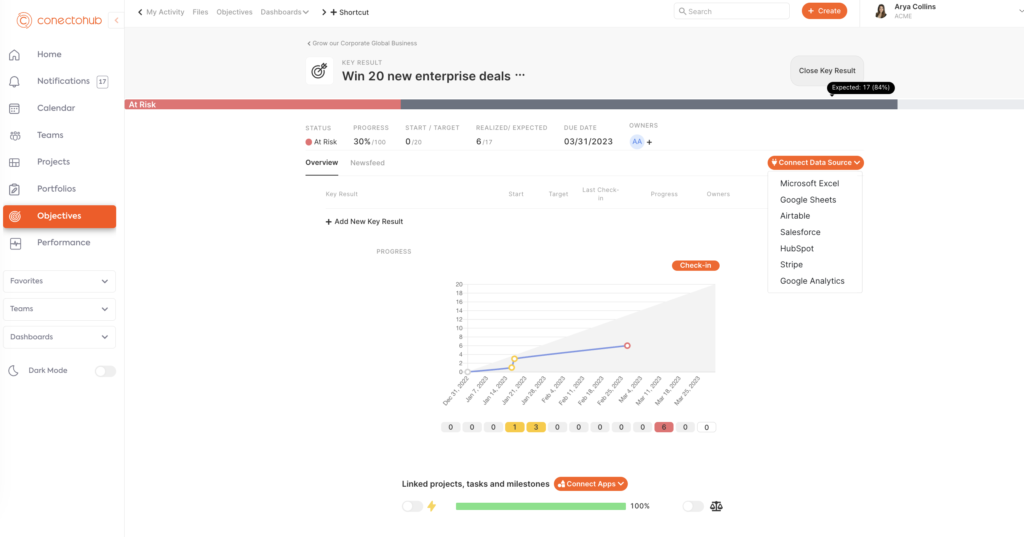
Also you can link your KRs with daily operations and see what are the teams doing to achieve their goals
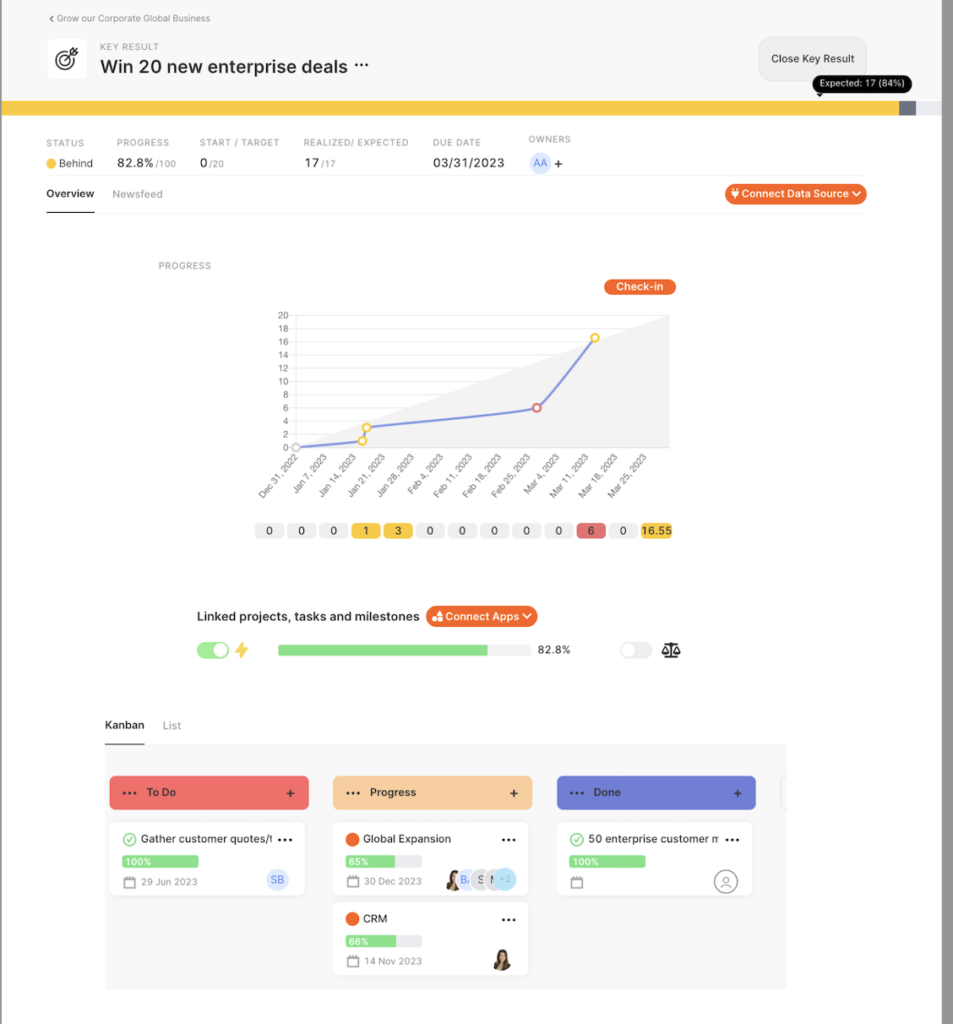
II. Increasing Efficiency of Operations
To increase efficiency of your operations, ConectoHub focuses on data and process optimization. Its Insightboards provide a comprehensive view of your organization’s performance, while performance and progress reports help you track ongoing progress.
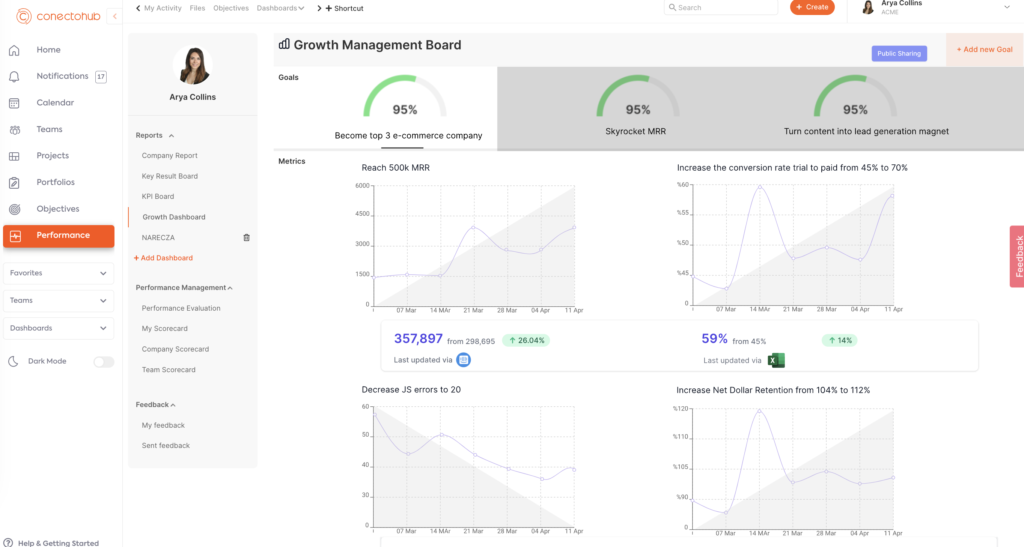
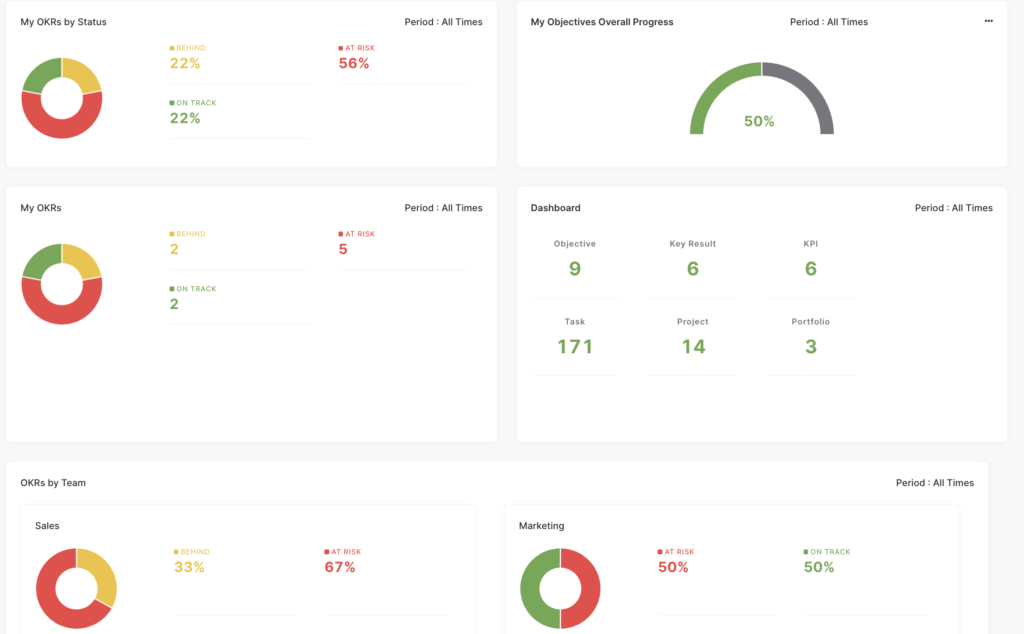
The key to scale is being able to collect, view and analyze all the relevant data in one place. Without both sides being represented, it’s impossible to really understand how the KPIs balance out. ConectoHub has made it a priority to build a solution that supports fast growing companies in being able to manage their strategy and daily execution from one platform and see every detail of their company instantly.
- With OKR System supported by AI, lead your company, set your objectives and get best Key Results
- Manage your business as usuals with KPIs.
- With automated OKRs and KPIs you can entegrate your goals with business metrics like sales, profit, etc. from +5000 platforms like Hubspot, Google Analytics, Excel etc. and see the progress automatically.
- Create performance system for your organisation. Give different weight to your goals. Finally access the performance of all the hierarchies in the organisation on the basis of work output instantly.
- ConectoHub provides a variety of ways to personalize your dashboard
- Manage your daily operations on the same platform where you are managing your goals.
If you want to see how fast growing companies from 14 countries scale fast with ConectoHub, let’s have a quick chat
